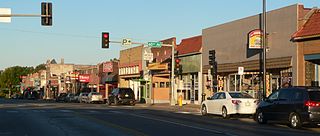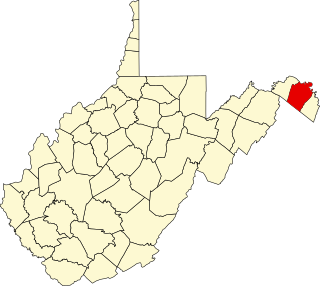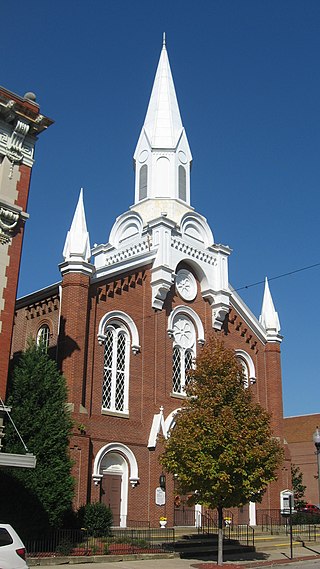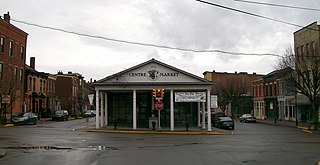
The National Register of Historic Places in the United States is a register including buildings, sites, structures, districts, and objects. The Register automatically includes all National Historic Landmarks as well as all historic areas administered by the U.S. National Park Service. Since its introduction in 1966, more than 90,000 separate listings have been added to the register.

Benson is a historic neighborhood in Omaha, Nebraska. Now a pocket within North Omaha, Benson Place was originally platted in 1887 and was annexed into the City of Omaha in 1917. Actor Nick Nolte lived in the Benson area before moving to the Westside district.

West Virginia Independence Hall is a historic government building at 1528 Market Street in downtown Wheeling, West Virginia, United States. It was built in 1860 under the supervision of architect Ammi B. Young for the federal government as a custom house, post office and courthouse. It is architecturally significant for its innovative uses of wrought iron as a framing material, and is historically significant for its role in the American Civil War. It housed the Wheeling Convention (1861), as well as the West Virginia Constitutional Convention (1863), which resulted in the separation of Unionist West Virginia from Confederate Virginia. This made it the only state to secede from a Confederate state during the war. The building was originally built as the custom house for the Western District of Virginia, and later became the center of government for the Restored Government of Virginia from 1861 to 1863, with Francis H. Pierpont serving as its governor. It was declared a National Historic Landmark in 1988. The building is now a state-run museum, housing exhibits on West Virginia history.

Fletcher Place is a historic district and neighborhood in the city of Indianapolis, Indiana named after Calvin Fletcher, a prominent local banker, farmer and state senator.

Brunswick is a passenger rail station on the MARC Brunswick Line between Washington, D.C., and Martinsburg, West Virginia. The station house, located at 100 South Maple Street in Brunswick, Maryland, is a former Baltimore and Ohio Railroad depot that is a contributing property to the Brunswick Historic District, which has been listed on the National Register of Historic Places since August 29, 1979. The station was designed by Ephraim Francis Baldwin and opened in 1891 on Seventh Avenue. Several years later the building was moved to its current location. It is a wooden frame building with stone walls up to the window sills, and features Palladian windows in the roof dormers.

This is a list of the National Register of Historic Places listings in Berkeley County, West Virginia.

The Nobility Hill Historic District is a residential historic district roughly bounded by Chestnut and Maple Streets and Cedar Avenue in Stoneham, Massachusetts. The district includes a number of high quality houses representing a cross section of fashionable housing built between 1860 and 1920. It was added to the National Register of Historic Places in 1990.

The Abell-Kilbourne House in Martinsburg, West Virginia is associated with John N. Abell, a prominent Martinsburg businessman and Charles W. Kilbourn, a Martinsburg mill owner. The former president of the Old National Bank, Abell developed the area known as "Abell's Addition" after his retirement in 1886. At that time Abell lived at 506 West Burke Street.

The Tree Streets Historic District is a 120-acre (49 ha) historic district in Waynesboro, Virginia. The aptly named district contains portions of Cherry, Chestnut, Locust, Maple, Oak, Pine and Walnut Avenues as well as portions of Eleventh through Sixteenth Streets and part of South Wayne Avenue. It covers the oldest residential neighborhood in Waynesboro, and reflects the various stages of development of the city from the 19th century through 1951. It was listed on the National Register of Historic Places in 2002. In 2002, it included 445 buildings deemed to contribute to the historic character of the area, two contributing sites, and seven other contributing structures.

First Baptist Church is a historic Baptist church at 813 Market Street in Parkersburg, Wood County, West Virginia. It was built in 1871, and is a two-story, three by six-bay, brick church in the Italianate style, which was popular at the time. It has a central steeple on the front facade and several rear additions. It is topped by a gable roof trimmed by an arched corbel table and corner turret. This congregation was founded in 1817 and built their first church in 1837. First Baptist was built on that site.

The Masonic Temple is a historic Masonic Lodge building located at Parkersburg, Wood County, West Virginia. It was built in 1915, and is a three-story, three-bay wide, red brick building with stone trim in the Classical Revival style. It features elliptical bays flanking the central bay on the front facade. The building was designed by Columbus architect Frank Packard with local supervising architect Theodore T. Sansbury.

North Street Historic District is a national historic district located at New Martinsville, Wetzel County, West Virginia. It encompasses 23 contributing buildings that include a residential and commercial area of New Martinsville. Most of the buildings in the district date to the late-19th and early-20th century in popular architectural styles, such as Stick Style, Queen Anne, and American Foursquare. Notable buildings include the Old Hospital Building, New Martinsville Grocery Company and warehouse (1895), former Cottage Hotel (1890), and the Moose Club.

South Church Street Historic District is a national historic district located at Lewisburg, Greenbrier County, West Virginia. The district encompasses six contributing buildings, including three single family residences built between 1908 and 1918. They are representative of the Queen Anne and Bungalow styles. Each of the houses has a contributing garage on the property.

Centre Market Square Historic District is a historic district in Wheeling, West Virginia, listed on the National Register of Historic Places.

Wheeling Warehouse Historic District is a national historic district located at Wheeling, Ohio County, West Virginia. The district includes 20 contributing buildings and 11 contributing structures. They are warehouses and commercial style buildings and structures between Main Street and the Ohio River. All of the buildings date to the late-19th and early-20th century. The warehouses are mostly two- and three-story masonry buildings. The two-story commercial buildings have storefronts on the first floor and residential units above. Notable buildings and structures include the Pump Store (1933), Wheeling Stamping Plant (1932), Allied Plate Glass, Warwick China, Boury Warehouse, Ott-Heiskell Company, Edward Wagner Wholesale Grocers building (1915), the Moderne style former Greyhound Bus Station, and Main Street Bridge (1891).

Avery Street Historic District, is a national historic district located at Parkersburg, Wood County, West Virginia. It is to the east of the Julia-Ann Square Historic District and south of the Parkersburg High School-Washington Avenue Historic District. Primarily residential, it encompasses 109 acres and includes churches, a school, and a small commercial area. Built as Parkersburg's first "suburb" in the late-19th and early-20th century in popular architectural style such as Colonial Revival and Queen Anne, the district exhibits 12 distinctive types of Historic architecture. There are 358 contributing buildings, 59 of which are considered to be pivotal. U.S. Senator Johnson N. Camden (1826-1908) owned most of the land now included in the district. Located in the district are the separately listed Parkersburg Women's Club and the First Presbyterian Church/Calvary Temple Evangelical Church.
The West Broad Street Commercial Historic District is a national historic district located at Richmond, Virginia. The district encompasses 20 contributing buildings built between about 1900 and the late 1930s. Located in the district is the Forbes Motor Car Company (1919), Harper-Overland Company building (1921), Firestone Building (1929), Engine Company No. 10 Firehouse, and the Saunders Station Post Office (1937). The majority of the buildings are two-to-four stories in height and are composed of brick with stucco, stone and metal detailing. Located in the district is the separately listed The Coliseum-Duplex Envelope Company Building.

The Battery Street Historic District encompasses one of the oldest developed areas of Burlington, Vermont. With a history dating to 1790, this area, south of downtown Burlington and initially bounded roughly by Main, St. Paul, and Maple Streets, and Lake Champlain, this area includes a mix of residential, commercial, and industrial uses, with architecture spanning from its early period to the 20th century, including one of the city's oldest houses. The district was listed on the National Register of Historic Places in 1977, and has twice been enlarged, extending west to South Union Street.

The Jeffersonville Historic District encompasses a significant portion of the village of Jeffersonville, the largest in the town of Cambridge, Vermont. The village, long the town's commercial heart, has a well-preserved array of 19th and early-20th century architecture. It was listed on the National Register of Historic Places in 1987.

The Maple Street–Clarks Avenue Historic District encompasses a historic 19th-century immigrant neighborhood of St. Johnsbury, Vermont. Located northwest of the downtown area on a sloping hillside, it consists of tenements and single-family houses built for Irish and French Canadian immigrants, sometimes grouped in ways that facilitated the support of large extended families. The district was listed on the National Register of Historic Places in 1994.






















